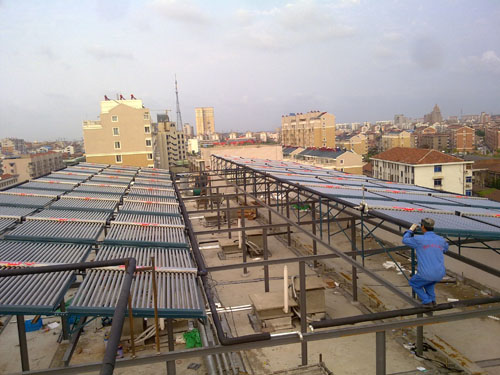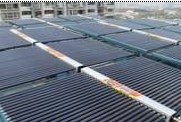Basic Principles combination solar water heater system design The heating load is generally much larger than the domestic hot water load. The heating load of each house depends on local climatic conditions, building size, insulation, ventilation, the degree of adoption of passive solar technology, the thermal load in the house, and the number of people in the house. According to relevant survey data, the heating load of the same building is usually the domestic hot water load 2 . 5 to 10 times. In a solar combined system, there are typically two sources of energy ( solar and auxiliary energy ) used to provide the heat required for two heat loads ( heating load and domestic hot water load ) . As long as there is enough solar radiation during the day, the solar collectors provide heat; otherwise, the auxiliary energy ( such as oil, gas, electricity, biomass, etc. ) supplements the lack of solar energy. However, solar composite system design must follow a basic principle: the solar collector should be operated at the lowest possible operating temperature in order to achieve the highest possible heat collection efficiency. Therefore, the key to system design is how to combine the technical characteristics of different energy sources and different heat loads to design a complete, durable, reliable and economical solar combination system. Temperature stratification of the storage tank In order to provide heat to two heat loads, the special performance combination system according to the heating load and the domestic hot water load should have hot water at different temperature levels at the same time. Of course, the easiest way is to use two water storage tanks with different temperature levels, and use intelligent controllers to drive different valves and pumps in order to achieve the purpose of providing heating and domestic hot water separately, but it is obviously necessary to do so. Increase the cost of the system. Another scientific method is to use only one water storage tank and use special measures to avoid mixing water at different temperatures in the storage tank. Since the density of hot water is always lower than the density of cold water, hot water is always located in the upper part of the water storage tank of the hot water combination system, and cold water is always located in the lower part of the water storage tank. This characteristic is called temperature stratification of the water storage tank. This article is provided by solar water heater project, Shanghai Magnesium Shuanglian Solar Factory
A salt lick is
a deposit of mineral salts used by animals to supplement their nutrition,
ensuring that they get enough minerals in their diets. A wide assortment of
animals, primarily herbivores, use salt licks
to get essential nutrients like calcium, magnesium, sodium, and zinc. When a saltlick appears, animals may travel to reach
it, so the salt lick becomes
a sort of rally point where lots of wildlife can be observed.
Farmers have historically provided salt licks for their cattle, horses, and
other herbivores to encourage healthy Growth and development. Typically a salt lick in the form of a block is used in
these circumstances, and the block may be mounted on a platform so that
domesticated animals do not consume dirt from the ground along with the
necessary salt. Salt blocks for farm animals can also be
treated with medications, which may be convenient when someone needs to
medicate shy animals, or a large group of animals.

Source: The authors: meishuanglian 
Salt Lick Block,Animal Feed Salt,Livestock Salt Lick Blocks,Animal Licking Salt Block
Weifang Xinchang Chemical Co.,Ltd , http://www.xinchangchem.com